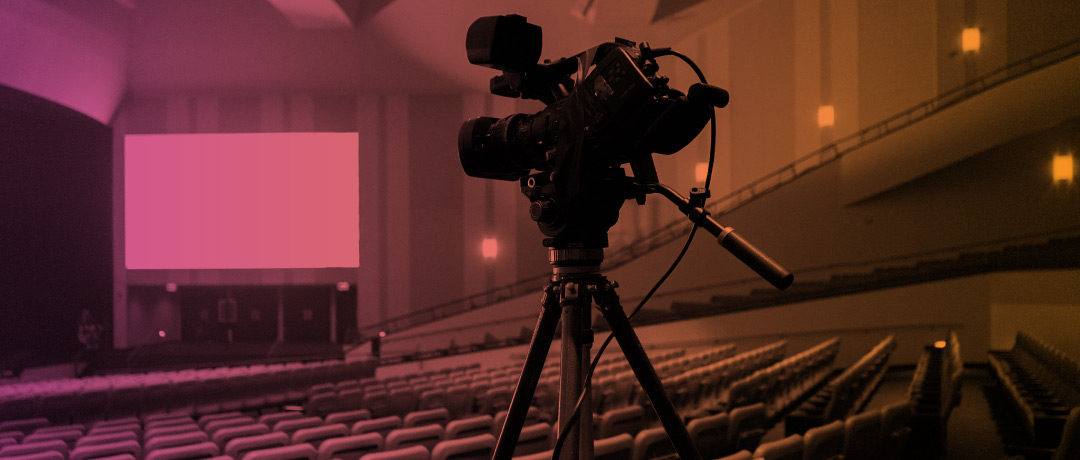Blog | 4 Ways to Livestream Your Church Services

4 Ways to Livestream Your Church Services
This is certainly a difficult time for many churches. The coronavirus (COVID-19) outbreak is forcing many churches to keep their doors closed until the pandemic is calmed, but amidst the chaos, we still hold a responsibility as believers to continue sharing the good news of Christ and assuring the world that God is in control. Unfortunately, that’s difficult to do if your church doesn’t know how to livestream services.
The good news is, livestreaming your church service doesn’t need to cost a ton of money! If you plan right, you can leverage platforms and gear you currently have to get your services livestreamed starting now! The degree to which you’d like to improve the production quality of your church service livestreams may require you to invest a bit of money, but there are solutions for churches of every size.
Approaches to Livestream Church Services
Keep in mind, switching (or adding) a digital medium to stream your services doesn’t mean you need to set up and perform your services the same way you always do. As you move your ministry online, you’re allowed to think outside the box and get creative with how you deliver your church’s sermon and music!
Approaches to Church Service Livestreaming
Here are a couple approaches to livestreaming your church services:
Instagram Stories | Instagram stories are a great way to stream your sermon. The most obvious benefit of using Instagram stories is that you can do it from anywhere! Your office, your couch, the living room, etc. All you need is your phone. Plan a 3 to 10-minute sermon and record it through Instagram stories.
The benefit to Instagram stories is that they are only up for 24 hours, so it’s easy to do one each week (or even multiple small ones throughout the week) that are up for the community during their usually Saturday-to-Sunday watching period. Another benefit is that you can add text summary or bullet points on each 15-second “segment” of the story to give people the big “takeaways” of your message.
Facebook Live or Instagram Live | Another approach to doing virtual services is to use Facebook Live or Instagram Live. The nice thing about using Facebook Live or Instagram Live to stream your church services is that all your followers will receive a notification that your church is going “live”, giving them a chance to react and tune-in.
A key distinction between Facebook Live and Instagram Live is that Facebook Live leaves your videos online indefinitely after you’re done recording. Instagram will only leave them up for 24 hours (similar to the stories feature).
Instagram TV | Instagram TV is great for long-form video, which may be perfect if you plan on uploading your service “as is” on a Sunday morning rather than taking different out-of-the-box approaches like Instagram stories. These videos can be between 10 to 60 minutes long, and the videos never expire, allowing you to keep your sermons up for as long as you’d like!
If you are looking to setup livestreaming for your worship services, here are a few practice ways you can do so:
Should We Just Stream the Sermon, or Worship Too?
The issue with streaming these days is all the copyright laws. If you are performing any music that’s not original, chances are it has copyright laws applied, and streaming your worship services may put you at risk of violating those laws.
The simplest answer to this question is – you should only stream your sermons. However, if streaming worship music is an absolute must for you, make sure you do the following:
Talk to a Professional | The copyright laws for performing copyrighted music can get pretty complicated. Don’t try to tackle it yourself – talk with a professional about what you are allowed and not allowed to do.
Obtain Appropriate Licenses | To play copyrighted worship music, you’ll need to have appropriate licenses. CCLI (Christian Copyright Licensing International) has a ton of helpful resources on obtaining appropriate licenses, as does CCS (Christian Copyright Solutions).
4 Ways to Livestream Your Church Services
If you are trying to get your church services online, the above methods are great “approaches” to communicating with your followers and the general public, but it still doesn’t answer the “how”.
As stated earlier, you don’t need to spend money to start livestreaming services, but depending on the production scale you plan to have for your livestreams, there are tons of paid options out there.
We’ll start with the simplest, cheapest approach and work our way to the more robust, production-heavy ways of livestreaming your church services:
Level 1: Mobile Phone
We all have one – and it’s all you need to get started with “livestreaming”. While it won’t necessarily be the same as using live cameras at your church location to broadcast your usual Sunday message, it’s a quick, cheap, and efficient way of getting your message out there.
Simply set up your phone on a tripod and record your sermon and upload it to Facebook, Instagram, and/or YouTube, or use Facebook Live and Instagram Live.
If you wanted to improve the quality of the sound, you could order a $30 external phone mic to attach to your phone, but that’s entirely optional!
Level 2: Dedicated Live Camera
If you have the budget and are looking to use a dedicated live camera, there are tons of options out there. You could use a simple camcorder, and there are many blogs on which cameras are best for different scales of livestreaming, so we won’t get into the details on those. However, a very famous option is the Mevo camera.
The Mevo camera is somewhere between $500 to $1,000 and is an excellent solution for having a dedicated live camera(s) for your worship services. They are significantly better quality than a mobile phone for those looking to up their production quality of livestreamed church services.
Level 3: Hybrid Method
The third, and subsequently more expensive method to livestreaming is to use a service like Boxcast, Restream, or OHS. Boxcast includes both the software and equipment necessary to livestream your services and is a major upgrade from using a Mevo camera, however, it’s quite the investment.
Boxcast costs around $100/month, and you’ll have to put in around $500-$1,000 up front to purchase a couple of good cameras and audio gear for livestreaming (assuming you don’t have any onboard). You’ll have to get creative with Restream or OHS, but with a bit of tweaking and dedication, any of these services will work great for livestreaming.
Level 4: HD Multi-Camera Method
As the name probably implies, this is a production-heavy approach to livestreaming services. Usually, churches livestreaming via multiple dedicated HD cameras have six-to-seven figure budgets and dedicated media and video teams. This may seem like the “Holy Grail” scenario to churches who can’t afford it, but here’s a bit of good news: It is not all it’s chalked up to be.
I have been creatively involved at many churches who have dedicated video teams and 10+ HD cameras rolling for livestreams. It almost always equates to problems, and while you may have a large media team, tracking down an issue when it could be one of a thousand things is difficult and incredibly stressful on a Sunday morning.
We doubt anyone with a seven-figure church media budget is reading this post, but frankly, we’d never suggest you go that route if you had the money anyways. Keep the video aspect simple so you can free up church volunteer hands to help elsewhere and place your focus on elevating the quality of what you do – not increasing the problems you have to deal with.
Can You Use ProPresenter for Livestreaming Church Services?
Yes – you absolutely can livestream your church services using ProPresenter! Keep in mind that you’ll need the right hardware, but as long as everything is setup correctly, you’ll be able to livestream your services from ProPresenter with ease.
ProPresenter supports live video feed via USB 3.0 and SDI, but it does not support firewire camera inputs, so make sure your video gear is compatible! According to their website, they officially support Blackmagic Design video interfaces, but other interfaces may work – we recommend you read up on forums that others have written to see if your own video interface will work with ProPresenter livestreaming. Here’s how to set it up:
Video Device | Go to the video device options within ProPresenter and select the correct input device for your video source. This could be your webcam, an external camera, a video interface, or a software (like CamTwist or ManyCams).
Audio Device | If you are using external audio (recording the message through the mic or the band through the soundboard), you’ll need to select an audio device. Within ProPresenter, select the audio source. We’d recommend finding a compatible audio interface and running the “monitor outs” on your soundboard into the inputs of your audio interface, plugging that interface into your computer via USB 3.0, and selecting the audio interface’s driver as your “audio device” within ProPresenter.
Preserve Aspect Ratio | Make sure you do this to avoid your camera video from being stretched to full width in case your output resolution and camera resolution are different.
Use the Cue Palette | The cue palette in ProPresenter allows you to put a video start que on a slide so the video begins automatically when you arrive on that slide. You can also add a cue on a slide to stop the video.

About the Author
Chris Fleming is a professional musician from Minneapolis, MN who has played with artists such as Kari Jobe, TAYA, Aodhan King, and Jason Gray. He is actively involved with the CCM scene and has contributed as a drummer, music director, song writer, and producer for various worship artists and churches locally and nationally. Chris is the Motion Designer at Motion Worship, helping to create motion background collections and countdowns for our subscribers.

Excellent information. Thank you, We too are a small church with a very small budget. Trying to endure and hold on during this challenging time but we too have a strong desire to be used by God to reach out to our own members and to the community. Thank you for the help and for the information.
We use obs software it is free. You can make scenes and have many different inputs. We have a camera as one input. Motion worship with a capture card as a second input and a presonas digital mixer for audio. You can even set a chroma key on obs so that motion worship scripture and lyrics is super imposed on your live stream with a transparent background
Bryan! I love this! Thanks for the comment. OBS is a powerful software for livestreaming, and yes, it’s a huge benefit that it’s entirely free! Love the ideas here.
What is the software used to made live scripture with chroma key in obs
Good job, a lot of great information. Small Church, very low budget, but still wanting to do our best to reach our community for Christ.
Hey Rick! So glad we could help. It doesn’t take too much to get started with livestreaming – that’s all we want people to realize.